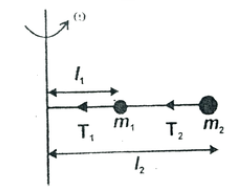A body of mass 40 gm is moving with a constant velocity of 2cm/sec on a horizontal frictionless table. The force on the table is
Zero
39200
160
80
The correct Answer is:A
To solve the problem step by step, we need to determine the force acting on the body on a horizontal frictionless table.
Step 1: Understand the given information
- Mass of the body (m) = 40 grams
- Velocity (v) = 2 cm/s
- The surface is frictionless.
Step 2: Identify the forces acting on the body
Since the body is moving on a horizontal frictionless table, the only forces acting on it are:
1. The gravitational force (weight) acting downwards, which is given by Fg=mg.
2. The normal force exerted by the table acting upwards.
Step 3: Calculate the gravitational force
To find the gravitational force, we need to use the formula:
Fg=m⋅g
Where:
- m=40 grams = 0.04 kg (since 1 gram = 0.001 kg, but we will keep it in grams for CGS unit)
- g (acceleration due to gravity) in CGS units = 980 cm/s²
Now, substituting the values:
Fg=40g⋅980cm/s2
Step 4: Perform the calculation
Calculating the force:
Fg=40⋅980=39200dynes
Step 5: Conclusion
Since the body is moving with constant velocity, the net force acting on it in the horizontal direction is zero. However, the force acting on the table due to the body is equal to the weight of the body, which we calculated as 39200dynes.
Thus, the force on the table is 39200 dynes.
Final Answer:
The force on the table is 39200 dynes.
---
- Mass of the body (m) = 40 grams
- Velocity (v) = 2 cm/s
- The surface is frictionless.
Since the body is moving on a horizontal frictionless table, the only forces acting on it are:
1. The gravitational force (weight) acting downwards, which is given by Fg=mg.
2. The normal force exerted by the table acting upwards.
To find the gravitational force, we need to use the formula:
Fg=m⋅g
Where:
- m=40 grams = 0.04 kg (since 1 gram = 0.001 kg, but we will keep it in grams for CGS unit)
- g (acceleration due to gravity) in CGS units = 980 cm/s²
Fg=40g⋅980cm/s2
Calculating the force:
Fg=40⋅980=39200dynes
Since the body is moving with constant velocity, the net force acting on it in the horizontal direction is zero. However, the force acting on the table due to the body is equal to the weight of the body, which we calculated as 39200dynes.
The force on the table is 39200 dynes.
Topper's Solved these Questions
- NEWTONS LAWS OF MOTIONBook:ALLENChapter:NEWTONS LAWS OF MOTIONExercise:EXERCISE-III
Explore 28 Videos
- NEWTONS LAWS OF MOTIONBook:ALLENChapter:NEWTONS LAWS OF MOTIONExercise:EXERCISE-I
Explore 52 Videos
- NEWTON'S LAWS OF MOTION & FRICTIONBook:ALLENChapter:NEWTON'S LAWS OF MOTION & FRICTIONExercise:EXERCISE (JA)
Explore 4 Videos
- RACEBook:ALLENChapter:RACEExercise:Basic Maths (Wave Motion & Dopplers Effect) (Stationary waves & doppler effect, beats)
Explore 24 Videos
Similar Questions
A car of mass 800 kg is moving with a constant velocity 40 km/h. Find the net force on it.
View SolutionA car of mass 800 kg is moving with a constant velocity 40 km/h . Find the net force on it.
View SolutionAn object of mass 2kg is sliding with a constant velocity of 4ms−1 on a frictionless horizontal table. The force required to keep the object moving with the same velocity is
View SolutionThe whole set up shown in the figure is rotating with constant angular velocity ω on a horizontal frictionless table. The ratio of tensions T1T2 is
(Givenl2l2=21)

View SolutionA girl of mass 40kg jumps with a horizontal velocity of 5m/s onto a stationary cart with frictionless wheels. The mass of the cart is 3kg. What is her velocity as the cart starts moving? Assume that there is no external unbalanced force working in the horizontal direction.
View SolutionTo keep a particle moving with constant velocity on a frictionless horizontal surface an external force
View SolutionA body of mass 6.25kg is travelling in a horizontal straight line with a velocity of 3m/ sec when a horizontal force P is applied to it at right angle to the initial direction of motion. If P varies according to the accompanying graph, remains constant in direction and is the only force acting on the body in its plane of motion,find the magnitude of the velocity of the body when t=2 sec.

View SolutionTwo blocks of masses m and m' are connected by a light spring on a horizontal frictionless table . The spring is compressed and then released . Find the ratio of acceleration of masses .
View SolutionA ball of mass 0.2 kg moves with a velocity of 20m/sec and it stops in 0.1 sec , then the force on the ball is
View SolutionA ball of mass 0.2 kg moves with a velocity of 20m/sec and it stops in 0.1 sec , then the force on the ball is
View Solution

